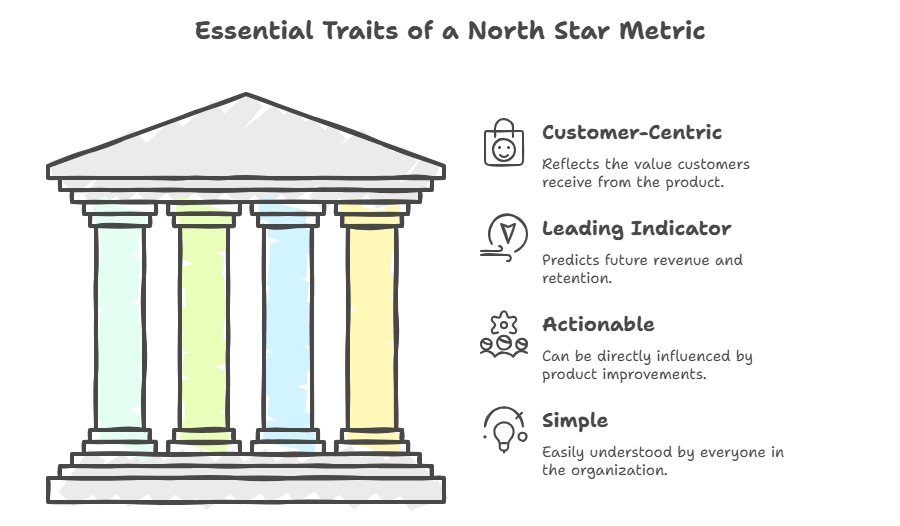What Is a North Star Metric? Definition and Examples
Learn what a North Star Metric is, why it matters for product teams, and how to choose the right one for your business with real-world examples.
What Is a North Star Metric?
A North Star Metric is a single, customer-centric metric that best captures the core value your product delivers to customers. Think of it as your organization's guiding star—the one number that aligns everyone toward creating customer value and driving sustainable growth.
According to Amplitude, a North Star Metric represents what customers value about your product and serves as the key measure of success for your product team. Unlike vanity metrics that might look good but don't reflect real business health, your North Star Metric should directly correlate with long-term success.
Why Your Business Needs a North Star Metric
Creates Organizational Alignment
When every team—from product and engineering to marketing and sales—focuses on the same North Star Metric, you eliminate conflicting priorities. Finmark explains that a North Star metric provides your business with a concrete way to measure growth across the organization. This alignment ensures everyone understands how their work contributes to delivering customer value.
Measures Product-Market Fit
Your North Star Metric serves as a reliable indicator of whether you're building something people actually want. As PostHog notes, North Star metrics are a way to measure product-market fit. When this metric trends upward, you know you're creating value that customers are willing to engage with repeatedly.
Drives Strategic Focus
Without a clear North Star, teams can easily get distracted by secondary metrics or short-term wins. A well-chosen North Star Metric ensures your product strategy remains focused on what truly matters for long-term success.
Characteristics of a Good North Star Metric

Customer-Centric
Your North Star Metric must reflect the value customers receive from your product. As Amplitude emphasizes, it should best capture the value customers derive from your product. If your metric doesn't connect to customer success, it's probably not the right North Star.
Leading Indicator of Success
A good North Star Metric predicts future revenue and retention rather than just reflecting past performance. It should be a leading indicator of success that correlates with long-term business health.
Actionable and Influencable
Your team should be able to directly impact this metric through product improvements and customer experience enhancements. If no one can move the needle, it's not a useful guiding metric.
Simple and Understandable
Everyone in your organization should be able to understand what the metric means and why it matters. Complexity defeats the purpose of having a single guiding star.
Real-World North Star Metric Examples
Spotify: Time Spent Listening
Spotify uses three North Star metrics to measure different business goals, with time spent listening being a primary focus. This metric directly reflects how much value users derive from their music streaming service.
Roku: Average Revenue Per User
Roku tracks growth through Average Revenue Per User (ARPU) as their North Star Metric. This makes sense for their business model, where increasing the revenue generated from each user indicates successful monetization.
Slack: Paid Team Growth
Slack's North Star Metric focuses on converting free users into paid plans, specifically measuring the growth of paid teams. This aligns with their freemium model and indicates successful value delivery that justifies payment.
How to Find Your North Star Metric
Identify Your Value Proposition
Start by understanding the core value your product delivers. What problem are you solving for customers, and how do you know when you're solving it well? Your North Star Metric should directly measure this value delivery.
Consider Your Business Model
Different business models require different North Star Metrics. A self-serve SaaS company might focus on active users, while an e-commerce platform might prioritize transactions completed. As Amplitude suggests, the first step is to figure out what "game" your business is playing.
Test and Validate
Your initial hypothesis about your North Star Metric might need adjustment. As noted in industry discussions, it's essential to revisit and potentially recalibrating your North Star Metric as your product evolves.
Visualizing Your North Star Strategy
Creating a mind map can help you explore potential North Star Metrics and how they connect to your business objectives. At ClipMind, we've found that visualizing these relationships makes it easier to identify the metric that truly represents customer value.
Our AI SWOT Analyzer can help you assess your competitive position, while the Product Idea Brainstormer can generate insights about what customers truly value—both useful inputs for determining your North Star Metric.
Common Mistakes to Avoid
Choosing Vanity Metrics
Metrics like total registered users or app downloads might look impressive but don't necessarily reflect real value delivery. Focus on engagement and outcomes rather than superficial numbers.
Having Multiple North Stars
The power of a North Star Metric comes from its singularity. While companies like Spotify track multiple metrics, they maintain clarity about which one serves as their true North Star for strategic decisions.
Ignoring Customer Feedback
Your North Star Metric should evolve based on how customers actually use and value your product. Regular customer research ensures your metric remains relevant.
Implementing Your North Star Metric
Once you've identified your North Star Metric, make it visible throughout your organization. Create dashboards that track this metric prominently, discuss it in team meetings, and ensure every product decision considers its impact on this key number.
Remember that your North Star Metric isn't set in stone. As your business grows and customer needs evolve, be prepared to reassess whether your chosen metric still represents the core value you deliver.
 ClipMind
ClipMind